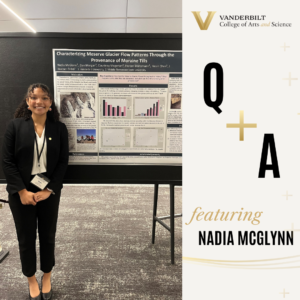Senior Nadia McGlynn wins NABG conference award
Nadia McGlynn, a senior double majoring in Earth and environmental sciences and anthropology, recently won first place for her poster presentation at the National Association of Black Geoscientists 42nd annual technical conference. McGlynn conducted research on Antarctic glaciers that furthers our understanding about how they respond to climate change. Hear from her below about her presentation and her plans for the future.
 Q. Can you tell us about the poster contest you won?
Q. Can you tell us about the poster contest you won?
A. I presented in the poster session for climate, environment, and geochemistry at the NABG 42nd annual technical conference. The theme for this year’s meeting was Geoscience United: Collaborating for a Sustainable and Equitable Future, and the conference was in Washington D.C. from Sept 27-30.
I had a great time! I won first place overall poster and was chosen from about 35 undergraduate and graduate students. The award was presented by Dr. Asmeret Asefaw Berhe, Director of the Office of Science at the U.S. Department of Energy.
Q. What was the subject of your presentation? What type of research did you complete for the project?
A. I was a member of Dean Dan Morgan’s Antarctic field team and worked in Antarctica from Oct 31, 2022 – Jan 8, 2023. We spent two months camping in the McMurdo Dry Valleys (MDV) and sampled glacially deposited dirt! Antarctica is about 98% covered in snow and ice, and the MDV is the 2% that is not. This allowed us to sample dirt and rock deposits directly. The glaciers in the MDV can also provide information about the behavior of the East Antarctic Ice Sheet (EAIS) as a whole because they flow into the EAIS and can move and change in response to climate conditions.
I spent 10 weeks this past summer doing geochemical analysis and preparing samples from one of our sites (the Meserve Glacier in Wright Valley, my teammates analyzed some other deposits) to gather information about glacial deposition, erosion, and weathering of the samples. I compared about 10 samples of dirt, bedrock, and ice from Wright Valley and found that samples from different areas in the valley were deposited at different times from the same glacier over the course of millions of years. This means that the Meserve Glacier has been flowing in the same direction for at least as long as the oldest deposit (U-Pb radiometric absolute dates pending). This information is important for constraining glacial history of the Meserve Glacier and the McMurdo Dry Valleys, allowing us to understand how glaciers and the EAIS respond to climate change, especially as we continue to anthropogenically impact the climate.
Q. What was it like presenting at the conference?
A. Only two percent of geoscientists are Black, and a fraction of those are women. As an EES major, it is very rare that I see my identities reflected in geology in general, let alone in the jobs I aspire to have. At NABG however, the entire room was full of scientists who look like me! I had a great time meeting amazing and successful scientists at the conference. I learned so much from the sessions and just from talking to people who came to see my poster. This was my first time presenting my work at a geology specific conference, and it was thrilling to be able to share my findings and receive thought provoking science questions and comments back. I went in very proud of my poster but also with my only expectation being to learn, so when I won the award it was very exciting! I loved my experience and I hope to go back to NABG for years to come.
Q. What are your plans for the future?
A. I am currently applying for fellowships and jobs for a gap year before applying to Ph.D. programs in Earth and planetary sciences next fall.
